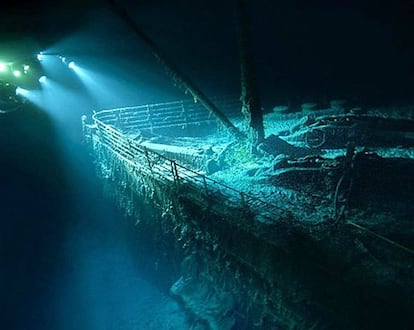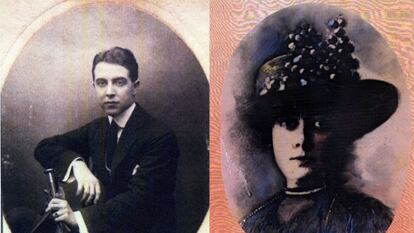The Spanish cost of Titanic
Among the vessel’s incredibly cosmopolitan passenger list and personnel were 10 Spaniards Seven of them would eventually reach the shores of America

When the Titanic steamed out of Southampton on its fateful journey on April 12, 1912 the highest of high society shared its voluminous interior with people from all walks of life — most seeking new lives in the land of opportunity over the Atlantic. But encounters between the classes were few until the frantic final hours of the voyage.
The passengers were divided by wealth but also by origin. The Titanic, a “floating city,” hosted a surprisingly cosmopolitan populace. The majority were American, British, Irish and Swedish but adding to the Babelian mix were Russians, Austro-Hungarians, Turks, Syrians, French, Germans, Belgians, Italians, Bulgarians, Finns and Norwegians, with a handful of Portuguese, South Africans, Chinese and Uruguayans and a sole traveler each from Holland, Japan and Mexico.
Also included in this eclectic mélange were 10 Spaniards: nine passengers and a crew member. Bucking the trend of the wider survivors’ list, the only fatality recorded among the Spanish passengers was its wealthiest member, Víctor Peñasco y Castellana.
Castellana was traveling with his wife, María Josefa, and her maid, Fermina Oliva y Ocana. The group was on the final stretch of a lavish honeymoon that had lasted 17 months and left somewhere in the region of 700,000 euros in the tills of the finest restaurants, hotels and jewelers across Europe.
In an echo of the 1997 James Cameron-directed film Titanic, a three-layered pearl necklace and a brooch from one of the most prohibitively expensive gem merchants in the French capital lie in a safe that belonged to the couple in the wreckage at the bottom of the Atlantic. For Víctor and María Josefa such extravagance was not unusual but a way of life. Víctor was a nephew to King Alfonso XIII’s prime minister, José Canalejas, and his family’s wealth was matched by precious few others in the realm; María Josefa’s was one of them.
On board, Víctor and María Josefa performed the starched-shirted rituals of the day, attending balls, playing cards and flaunting their glittering opulence. Their combined fortune after marriage was somewhere shy of a billion euros in today’s terms.
Peñasco was nephew to King Alfonso XIII’s prime minister,
On the evening of April 15, E. J. Smith, the Titanic’s captain, gave a dinner for first-class passengers. Dressed in their finery, Víctor and María Josefa tarried awhile after the banquet chatting with some Argentinean friends of theirs, José Pedro Carrau and his nephew Francisco. Later, they returned to their suite and began preparing for bed. It was at this moment that a loud noise resonated throughout the ship, from bow to stern. Víctor put his dinner jacket back on and went up on deck, where, in polished English, he asked a group of officers what had happened. Their response turned him pale: the ship had hit an iceberg and the panorama was not encouraging.
Returning again to his rooms, Víctor instructed Fermina and María Josefa to put on their lifejackets and the three hurried outside. Víctor, whose occupation was listed as that quintessentially Edwardian misnomer “gentleman,” proved to be exactly that. María Josefa and Fermina were directed to lifeboat eight, which was under instructions to get as far away from the Titanic as it could.
Fermina, seeing that Víctor had disappeared, ran through the crowds frantically seeking her employer while María Josefa shouted for her husband. Unable to find him, she returned to the lifeboat. “I was terrified,” she said in 1962. “I didn’t want to look. Suddenly we heard a terrible noise, as though a mountain was crashing down. When I turned around again to look the ship had gone, as though it had been swallowed up by a mysterious throat.”
Víctor’s body was never recovered, or if it was it was one of 150 unidentified. His death certificate states he is buried at Fairview Cemetery in Halifax, Nova Scotia, possibly orchestrated to allow María Josefa to remarry, which she did six years later to Baron Río Tovía. She died in Madrid in 1972 aged 83. Fermina, who was from Cuenca, died in 1969 aged 98.
Suddenly we heard a terrible noise, as though a mountain was crashing down”
Víctor Peñasco y Castellana was the only Spanish passenger recorded as losing his life on board the Titanic, but he is not the only Spaniard listed as buried in Nova Scotia. Servando Oviés was the son of an importer, Ramón Oviés, whose family business was based in Havana, where Servando lived with his wife and son. Oviés joined the Titanic at Cherbourg on a first-class ticket, and was lodged in cabin D-43.
In life Oviés was, if not quite to the extent of the Peñasco y Castellanos, a man of considerable means. In the confusion following the disaster, he was first classified unidentified and later reduced to a few short words on a Halifax Medical Examiner’s report. Listed as male, estimated age 28, with dark hair, the 25-word document ends: “Probably a sailor.” A handwritten note underneath read: “No clothing or effects in Coroner’s office.” He is buried at the Mount Olivet Cemetery in Halifax.
Jean Monros was born in Spain, lived in London and worked as a waiter on board the Titanic. Like Oviés, his body was recovered by the steamer Mackay-Bennett, contracted by the White Star Line in the aftermath of the disaster to recover the dead. Thought to be 19 or 20 years old, Monros was also making his maiden voyage. He was buried at sea on April 21, 1912.
All passenger and crew information from White Star Line Contract Ticket List and Nova Scotia Public Archives.
The survivors

- Encarnación Reynaldo was born in Marbella and boarded Titanic at Southampton. She escaped in lifeboat number nine and was rescued by the Carpathia.
- Julián Padró Manent, a chauffeur from Catalonia, was traveling to his home in Havana, probably in the company of the sisters Florentina and Asunción Duran y More, both from Lérida. The sisters were rescued by Carpathia in lifeboat 12, while Manent found his way onto lifeboat nine. Florentina and Julián later married and lived in Havana, Cuba, where they died in 1959 and 1968, respectively. Asunción's eventual fate is unknown.
- Emilio Pallas y Castelló, of Barcelona, also embarked at Cherbourg and joined Manent in lifeboat nine. He died a day before the 28th anniversary of the disaster on April 14, 1940.
Tu suscripción se está usando en otro dispositivo
¿Quieres añadir otro usuario a tu suscripción?
Si continúas leyendo en este dispositivo, no se podrá leer en el otro.
FlechaTu suscripción se está usando en otro dispositivo y solo puedes acceder a EL PAÍS desde un dispositivo a la vez.
Si quieres compartir tu cuenta, cambia tu suscripción a la modalidad Premium, así podrás añadir otro usuario. Cada uno accederá con su propia cuenta de email, lo que os permitirá personalizar vuestra experiencia en EL PAÍS.
¿Tienes una suscripción de empresa? Accede aquí para contratar más cuentas.
En el caso de no saber quién está usando tu cuenta, te recomendamos cambiar tu contraseña aquí.
Si decides continuar compartiendo tu cuenta, este mensaje se mostrará en tu dispositivo y en el de la otra persona que está usando tu cuenta de forma indefinida, afectando a tu experiencia de lectura. Puedes consultar aquí los términos y condiciones de la suscripción digital.








































